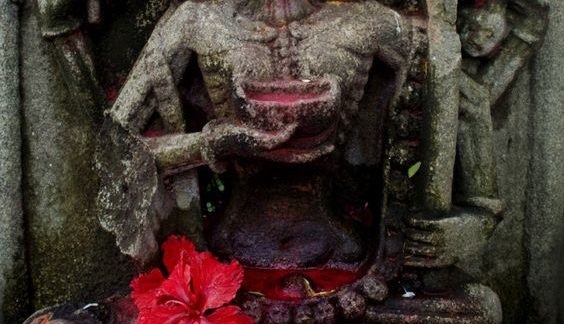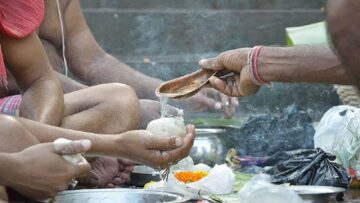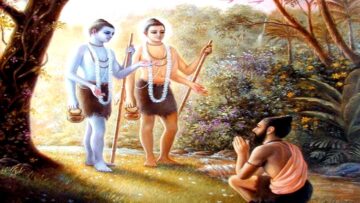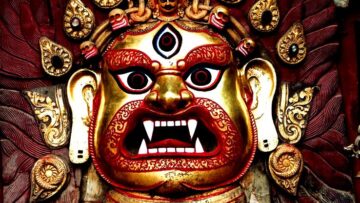Recently there was a judgment from the Tripura HC banning the ritual of pashubali in the famous Tripurasundari Mahavidya temple as well as all other Hindu places of worship in the state. In a series of such judgments starting from the Jallikattu to Sabarimala and now this, it’s evident to anyone with half a brain that only one faith is being targeted systematically and may I add, maliciously, perhaps perceived as soft and subject to the machinations of a heady cocktail of activism and reformation bug which afflicts many modern Hindus, including, and sadly, even judges.
What is alarming though is that many ordinary Hindus seem to support this, or claim that this fundamentally wrong and overall a good step, but since courts have not banned the Islamic sacrificial ritual of Qurbani during Eid hence it is discriminatory. That points at a bigger and more dangerous, and self-defeating error in the very thought process of Hindus in general. Clearly, a lot of us do not have much idea about the right method of judging the validity or otherwise of a traditional ritual, too influenced by simplistic ideas of social welfare and humanism as many seem to be. Not that these are wrong per se, but then any idea even the noblest one lifted out of context and applied universally becomes a retrograde and unthinking tyranny.
Pashubali in Tantra-s
There is evidence that at an earlier time pashubali was prevalent even in Vedic sacrifices, today however all that has been replaced by replicas of the actual process. So sacrifices that happen today are mostly in the Shakta temples, that too those where the Kalikula modes of worship is prevalent, particularly in Eastern India or Northern India like the famed Vindyavasini Durga temple in Vindyachala or this Tripursundari temple in Tripura. In the Tantric texts, which are more like manuals for sadhakas, bali is clearly sanctioned process without which the upasana of the devata is never complete.
It is imperative to understand here that the Hindu idea of deities is very different from the Abrahamic idea of a monotheistic God. A deity, for those who are unaware, is like a Divine Personality that has its own liking and disliking. So while we offer Tulasi to Visnu, we are required to give bel patra to Shiva and not the other way round. Every ritual, every ingredient used in the upasana is based on the requirements of that specific devata and is thus inviolable. The simpleminded question that comes up in some quarters, mostly from those who are superficially educated in the intricacies of Hindu upasana padhyati, about what would happen if one mixes things up based on whims and fancy, say offer Tulsi to Shiva instead of bel, and then the query is followed up with another superfice about how God can never be angry irrespective of what is offered or not etc is all a result of complete misunderstanding of this whole process of upasana. Of course, nothing will happen in the above mentioned theoretical eventuality of mixing up offerings except that the upasana will remain unsuccessful and bear no fruit. And this is where the shastras matter most, for they tell us how exactly one must proceed in order to advance in the worship of a specific deity in the Hindu pantheon. Further, it is understood that the shastras are written by siddhas and masters who had perfected that mode of upasana and then clearly noted down for future generations how each path must be traversed.
That the upasana of certain forms of Shakti, particularly some of the Mahavidya-s or 10 great goddesses of the Tantric world, need a pashubali is most clearly stated in the Tantric texts. Even simple stutis to the Devi make note of this fact. In one praise to the Mahashakti in the form of Ugratara, the Devi is referred to as balihomapriya – one who loved bali and homa. A 16th century stotra to Devi Kamakhya (who is worshiped as Kalika) from the Yogini Tantra describes Her as chagabalitustha – one who is happy with goat sacrifices. Even the widely famed Devi Mahatyam or Chandipaath from the 6th century, which is arguably one of the most cardinal texts of ShaktOpasana records in the 12th chapter this verse where the Mahadevi speaks to the devotees:
jānatājānatā vāpi bali pūjāṃ tathā kṛtām| pratīkśhiśhyāmyahaṃ prītyā vahni homaṃ tathā kṛtam
“I will accept with love the bali and puja that are offered and the fire-offering that is done likewise, whether they are performed with due knowledge (of sacrifice) or not.”
In the 10th century Kalikapuran which was composed around the original Shaktipitha of Kamakhya there is a whole section called Rudhiradhyaya or roughly translated, “blood episodes”, dealing with the exact process of how bali must be offered to various forms of the Divine Shakti in order for the sadhana and upasana to succeed. All these are an integral part of Vamacara Tantra. The text goes onto state that bali is the best of all methods of upasana for Chandika, Bradrakali, Ugrachanda, etc. forms of Shakti, for it brings about the swiftest results, and then the text exhorts all Tantric adepts to perform balividhan – as it is formally known – for it brings great delight to the Devi. A mahisabali to Chandika, it says, makes Her for a 100 years. From bringing the sacrificial animal to worship of the khadga invoking appropriate mantras, to the manner in which the blood has to collected and offered to the deity, every single detail is mentioned in texts. Accordingly in certain famous Tantric temples when a Mahisabali is conducted the first blood is not allowed to be spilled on the ground, but captured in a specific vessel kept nearby, and taken straight inside the garbagriha of the Divine Mother and offered to Her accompanied by mudras and mantras.
In paramparas, it is believed that a bali can also be done without the actual physical slaughter, where a ritual is performed and the appropriate pashu – one with specific signs on its body – is offered to the Devi. If correctly done, the animal won’t survive more than a week and the exact manner of death will depend on the form of Devi to whom the bali had been offered. To the uninitiated, it would look like a “natural” death, but for the initiated, it would bear all the signs of a bali. Sacrifice is integral to ShaktOpasana. Of course this kind of a ritual cannot be executed by the laity, it needs perfection and siddhi in the sadhana.
The text even speaks of the controversial subject narabali but with strict caveats of when such is to be done and who has the adhikara to perform this ritual. Historical documents mention that many of the Hindu kings who ruled over places like Assam and whose chief deity was Kamakhya would often bring the captured soldiers, especially higher-ranking enemy combatants from the Mughal forces, and offer them as a sacrifice to Kalika. Basically, an injunction from the Tantra shastra was used as a means of executing capital punishment for enemies of the state. Tripura temple too had a reputation for the same. While any kind of manslaughter is strictly outlawed in our modern world and rightly so, we still have state-sanctioned capital punishment for those waging heinous crimes against humanity. There was also the late medieval instance of thugs who would rob unsuspecting victims and sacrifice them at the Vindyachala mountains in Mirzapur district in the cave of Kali or Kalikoh. This, of course, had zero links to any textual sanction and was a clear violation of the strict rules set down. But this cannot be equated with pashubali that is done, for the world has not turned vegetarian yet, it never was and it never will. Till men continue to consume meat, and have an omnivorous diet, it is perfectly within the fundamental religious rights of the Vamacara Tantrika-s to offer pashubali to their beloved deity as well.
It must be mentioned in this context something that is widely accepted in the appropriate circles where Vamacara practices are in vogue, that it is not the flesh, bones, skin or anything else that is of any significance of the deity, but the blood which is considered as one of best transmitters of pranashakti and when offered to some forms of Devi delights and exalts Her, and She, in turn, blesses the sadhaka and also ensures a higher rebirth for the sacrificed animal. In Tantra, there is a vast substratum of practices handed down generations after generations in sampradayas which can be roughly called Vastu Tantra. Meaning the right ingredient, offered at the right time and at the right place to the appropriate form of devata, along with the exact mantra, can bring about a great and visible effect in the upasana, both internally and externally depending on the aim of the ritual, which can be experienced first hand without fail. For example suppose a certain Tantric ritual requires the upasaka to chant a mantra 1000 times using a coral mala then doing the mantra even one less or one more invalidates the sadhana, or changing the mala from coral to anything else also leads to a botched ritual with no result. Then the offering that must be made to the devata has to be exact and precise, not based on random likes and dislikes or whatever is available. So if a ritual says pashubali needs to be offered via a sacrifice, then it will only work when a bali is given, no other way can it succeed. For every ingredient in the world has its own guna – attributes – and like mystical chemistry when the right things are mixed in the right manner using the appropriate mantric force, it is bound to bring a clear, and unambiguous result. This principle lies at the very heart of all Tantric sadhana whether Dakshinacara or Vamacara.
Gentle Mother, Violent Mother
“How can a Mother take pashubali?”
A question which is often asked these days is why do we need to worship such forms or a variant of it that God is all kindness and love, He or She can never demand a sacrifice. Or that just bhakti to the Divine is enough, what need for all these “gruesome” methods? This is a naive question born from a cocktail of ignorance and Abrahamic thinking. People tend to confuse a deity with human measurements and human sensibilities which keep changing every few decades. From this stems another misguided query – how can a Mother (Devi) take pashubali? Of course, She can, and very often does. When the texts colloquially call Her mother, it is mainly a kind psychological device of upasana to create a meaningful mode of interaction with what is essentially a terrific non-human Force. Mahakali is a Mother for the capable sadhaka once She accepts the upasaka as Her child, but no amount of modern whitewashing can remove that blood-dripping Khadga from Her hands, nor change her lolling blood-red tongue or tame Her unstoppable vehemence. Destruction is as much a part and parcel of Her domain as creation. It is very very important to realize that a deity is not like a human being, neither in their perspective of the universe nor in their eternal presence. It is the upasaka who must adhere to the likes and dislikes of the devata as stated by the Shastras if one must safely approach the deity and not the other way round, that is, to expect the gods to bow before our limited mentality and weak emotionalism.

Hindus are perhaps the only race who have envisioned the divine in all kinds of forms, from the gentlest and sweetest to the most terrible and terrifying. Even the flute-playing Krishna of Bhagwatam turns into a most deadly Viswaroopa form, so fierce that a warrior of Arjuna’s caliber shrunk into fear seeing that terror-inducing Cosmic manifestation. The Devi Mahatyam describes the Divine Mahashakti as the gentlest of all, soumyati soumya, and yet the fiercest of all, ugratiugra. A cursory reading of the Chandipaath shows extremely graphic details of the warfare that Chandika waged against the Asuric force, including descriptions where Chamunda and the matrika-s drink the blood of asuras and dance intoxicated to the rhythm of battle drums. The Goddess of the text signifies a path of warfare, literal or psychological, and it is but natural that sacrifices would have been common in the worship of this deity. Not only pashubali but also various other heterodox and subliminal conditions were encouraged through the Vamacara route to re-enact that state of intense psychological tension, like as if in a war, in order to awaken certain latent states of human consciousness. Only those with certain mental makeup can appreciate and walk this route without self-destruction, others will recoil from horror and shock. This then is the true beauty and diversity of dharma that it includes all kinds of paths for every kind of person because what works for one may not work for another. Unity is not uniformity. And accordingly, each path and each approach has its own set rules and processes.
What about bhakti then? Bhakti is vital, but it is not enough. More important is Shraddha, a living faith in the efficacy of the path shown by the acarya-s and siddhas who gave walked before. The aim of the Tantric sadhanas was/is to attain mantra and tantra siddhi, finally ending in a siddhi or accomplished communion with the deity and for that exact steps are needed. Even in the modern biographical narrative about the Aghori Pratap Mody as mentioned in a series of books called Aghora – at the Left Hand of God, we find that even a hardcore vegetarian Vimalananda had to offer meat and blood when Smashan Tara appeared in front of him during a midnight ritual in a cremation ground in Bihar. If Bhakti were perfect nothing else would be needed, but such ideal bhakti is nowhere to be found in human beings, which is precisely why rituals and rules were made by the rishis and siddhas.
So any argument that Vamacara sadhana should replace balividhan is in direct contraction to the shastras and a clear recipe for failure of the sadhana. Even Ramakrishna who towards the end of his life ate very less, and never anything non-veg would still offer his namaskaras when a slice of meat from bali was presented to him, for that, according to the Kali upasaka, was prasada of the Divine Mother. Those who are disinclined for such practices can always try the dakshnicara route, but at no point can anyone else, least of all an outsider with zero direct experience or achievement in this path, has any adhikara to pass judgment on what to do and what not to do, or try and change the practice of pashubali, for these methods have been established by Siddhas who walked before, and by their very lives demonstrated how this path leads to the higher communion with the devata, such that the very body of the sadhaka becomes a yantra capable of holding Her infinite power, while the sadhaka’s mind becomes a constant mantra. In this manner the limited human is transformed into an unlimited living god and this indeed is mukti for the Tantra sadhaka.
Essential vs non- Essential Practice: The Judgment
Who decides what is essential? The shastras and the main devotees of the path, or those who have no faith on that path but are external activist-observers seeing things through their own agenda and bias. Why should their views be given more importance than that of actual practitioners?
The Tripura HC judgment claimed bali is not an essential practice based on a document by a British colonizer. How exactly and since when have aliens been given the right to decide what is essential and non-essential to a sampradaya? When did the Courts become experts in matters of religion? It is precisely for this reason that till mid-1800 all courts used to have pundits for interpreting the shastras. Unlike single-book religions Dharma is a broad umbrella of multiple sects and sampradayas tied via certain fundamental reverence for the spiritual geography of this land yet differ vastly in both actual upasana and doctrines. Water from the Ganga is revered by all sampradayas for their rituals, much as Shiva is regarded as Parameshwara from the core Vedic paths to the most heterodox Tantras, though the system and rituals have drastic variances in each case. Alcohol is to be totally shunned in a Vaidika path, while Tantra -s allow upasakas to offer consecrated alcohol to the deity. To claim that someone sitting in the high office of the State machinery or system has a complete understanding of these matters, of each path, is absurd and unnecessary. In fact, as long as life and public morality are not endangered commonsense dictates nobody has any business interfering or passing any judgment, moral or otherwise, on the beliefs and practices of any Hindu sampradaya. Is the court, going to ban all non-veg food now? How exactly does the piece of meat appear on the plate if not via slaughter?
Let’s briefly look at some of the main points mentioned in the judgment and analyze them.
The judgment says that pashubali is not essential, many devotees do not give pashubali, therefore it can be banned. Wait, many devotees may not offer flowers to the deity as well and do a simple namaskara, so next are you going to ban flowers?
In fact, given the vast range of options provided in Hindu mode of worship a Vaishnava may not go to a Shakta temple and vice versa, does that mean the deity itself is not essential then? Following this logic how long before the honorable courts declare the very idea of worshiping multiple deities, especially aggressive forms like Kali, Nrsimha, etc. as non-essential to Hinduism and ban the practice? This concept of essential practice seems more like monotheistic propaganda with strong retrograde colonial Christian influences, a tool that was widely used by padres to berate Hindu practices. Alarming that even after 70 years of independence in a country with 80% Hindu population such an outdated mode of thinking has percolated into the highest echelons of power.
The judgment further says the right to life must extend to animals, birds, insects and every living organism. Excellent, then please ban the use of all flowers, coconuts, sugarcane, etc. that are used in temples. Apart from pashubali, the Tantra also recommends the offering of kushmanda and sugarcane as sacrifices to certain forms. But logically even these have life and if we must accord them the same status as human life, then ban their use as well, isn’t it? I am curious to know how exactly can we ensure the right to life for bacteria and microbes – stop breathing maybe? Sri Aurobindo had once made a remarkable observation that India has faced a severe decline in basic thought-power since medieval times. Decades after independence we do not seem to have made much progress in this department.
Then the honorable judges say animal slaughter causes diseases! So all non-veg restaurants are spreading disease then, and more remarkably no scientist has been able to figure it out yet? Truly amazing!
Further, the judgment says religious rights are subject to health and animal slaughter affects mental health. Where is the scientific study which has been conducted for this and says so? I mean with due respect everyone can have an opinion on everything, but not all opinions need be taken as sacrosanct especially those which are devoid of any evidence.
Judges also seem to have decided that the pashubali is a superstition and done out of “unsighted conviction”. This is a ridiculous atheist-speak, God itself is an “unsighted conviction” by this line of argument, so ban religion perhaps? How many can say they have seen a deity or a god, and some religions can even kill if you say you have seen their God.
A minority of devotees may not like this practice so their rights have to be respected. Well, a minority of devotees can stop going to a place they do not like, no? What is this whole twisted idea of making the majority beliefs subservient to the minority at all cost, especially when it is causing no direct harm to any other human of course? If someone claims for example that certain practices of Islam are offensive to their sensibilities and that they would like to go to Mosques but not do the namaz instead bring an idol of Nataraja and do abhisekam, should courts allow that, using the principle that minority “feelings” must be respected?
Amazement never ceases reading this judgment. We are now told that tourists will not like this. So temples must now become malls and museums or maybe zoos to attracts tourists? What business does anyone have inside a holy kshetram who does not believe in the deity and the path to the deity as mentioned in the shastras?
While legal experts can opine better on what is the next logical course of action and thankfully the State Govt. has decided to challenge this judgment, it is good to remember that the Prevention of Cruelty Act of 1960, makes it clear in section IV, that the act by itself does not apply to animal sacrifice:
“Saving as respects manner of killing prescribed by religion.―Nothing contained in this Act shall render it an offence to kill any animal in a manner required by the religion of any community.”
From a common citizens’ perspective, it looks more like a case of individual judicial activism rather than an objective application of the law.
Epilogue
Pashubali is finished in 95% of Shakta temples and only in some, where the deity is capable enough and loves the sacrifice, this practice is still in vogue. Given that millions of animals are eaten across the world daily and at no point in the future is the world going to turn miraculously vegetarian, there is zero reason to artificially impose a ban on this very essential practice of Vamacara upasana. It cannot be said whether the animal sacrifice will be stopped when the judgment is challenged in the SC, but thus far even reading this excellent piece of jurisprudence has definitely slaughtered every last iota of commonsense. Sarcasm aside, this judgment sets a very dangerous precedent and using this kind of questionable logic of “essential practice” viewed through a monotheistic prism, one can eventually end up banning all Hindu practices or even worship of deities. After all it is not essential for a Hindu to worship all deities, just like it is not compulsory to give pashubali but based on the upasaka and desires of the individual, so can that mean, in theory at least, someday our august judicial system has the power to ban worship of certain deities based on the whims and biases of the judge? Especially maybe they will make an argument against ugra forms calling them non-essential? What safeguards are there to prevent such an eventuality because clearly the right to religious practice was completely ignored in the case of this order which reads more like a PETA activist’s personal diary, rather than a logical, measured and dignified legal document.
Feature Image: Pinterest
(The article was earlier published on indiafacts.org in 2019)
Disclaimer: The opinions expressed in this article belong to the author. Indic Today is neither responsible nor liable for the accuracy, completeness, suitability, or validity of any information in the article.










